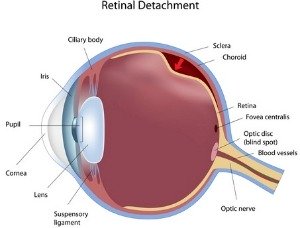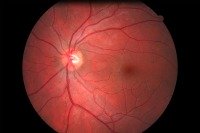|
What is a Retinal Problem?
A Retinal Problem is any condition affecting the back of the eye, or Retina. The Retina has ten layers of cells and membranes with important physical, optical and metabolic functions. The diagrams below show the location and structure of the Retina. The Retina serves as a physical barrier that protects its nerves from unwanted molecules found in the Choroid external to it. In order to view the content, you must install the Adobe Flash Player. Please click here to get started.
The Retina absorbs light energy and cuts down on light scatter, improving resolution of images. It also acts like a pigmented barrier to prevent excess light coming through the Sclera (the outermost white area of the eye), which would decrease the resolution of imagery. The Retina acts like the film in a camera. Light rays from an object viewed come through the eye’s Cornea and Lens and are focused on the Retina. The Retina then converts these images to electrical signals and sends them via the Optic Nerve to the brain. The Retina has a rich blood supply, and when these vessels are affected by disease, then bleeding, leaking of fluid, and/or Eye Strokes can occur. 
When your eye doctor looks at your Retina, the image that he or she is looking at looks like the picture below. Your eye care provider will observe important features of your Retina such as the Macula, the Optic Nerve, and the blood vessels. Also, your eye doctor will look for any holes, tears, or detachments of your Retina as well as any elevations and moles, which can suggest tumor formations.
What does it mean if you have 20/200 vision? What a person with 20/20 vision can see 200 feet away, you can only see it if you are 20 feet from the object. In other words, the object is very large and you have to get very close to see it. How can this affect your life? When you read, you have to get very close to the words to be able to see it. By getting so close to the reading material means that you will only have one or two words in your view at a time. The print has to be large. Driving will not be possible. ARMD can have a great deal of impact in your life and as recommended for other visually debilitating diseases, visits to a Low Vision specialist and mental health provider may be necessary. Managing your Retinal Problem
ARMD may initially be managed with periodic eye examinations, nutritional supplementation with antioxidants like lutein, zeaxanthin, and lycopene, and sunglasses with Ultraviolet protection coating. The periodic eye visits will be to monitor for any progression. Lutein and zeaxanthin are caretenoids found in very high concentration in the Retina. They are the two most important dietary antioxidants for eye health in terms of absorbing visible light rays (particularly blue light) that cause ARMD. Lycopene is a red caretenoid dietary antioxidant (found in red-fleshed fruits such as tomatoes, red grapefruit, guava and watermelon) for eye health that is also helpful in slowing the effects of ARMD. Another disease involving the Macula is a Macula Hole. The severity of the symptoms is dependent on whether the Macula Hole is partial or full-thickness. For example, partial holes only affect part of the macula layers, resulting in wavy, distorted, and blurred vision. On the other hand, full-thickness holes can cause a complete loss of central vision. Optic Nerve problems are neurological problems since these diseases interfere with the Retina’s ability to convert images to electrical signals and send them to the brain. Diseases like Glaucoma, Multiple Sclerosis, Brain Tumor(s), High Intracranial Pressure, Malignant High Blood Pressure, Diabetes, Eye Strokes, or Brain Strokes can cause damage to the Optic Nerve. Many of these diseases may affect the Optic Nerve by damaging the blood supply to the nerve. Diabetes, for example, may cause the blood vessel walls to become porous and leaky. This may lead to bleeding, leaking of fluid and decreased blood supply to the structures of the Retina. This condition is known as Diabetic Retinopathy. The incidence and severity of Diabetic Retinopathy increases with the duration of diabetes and is likely to be worse if control of the diabetes is poor. The critical factor in prevention and slowing progression of Diabetic Retinopathy is tight glycemic control and compliance with your diabetic regimen. Large fluctuations in glucose levels can cause damage described above to blood vessels of the Retina. Other causes of blood vessel damage to the Retina include High Blood Pressure and Eye Strokes. The Retina and/or Optic Nerve can be cut off from the nutrients and oxygen flowing through your blood by an Eye Stroke. If you experience sudden vision loss, you need to go immediately to your eye care provider. If you do have an Eye Stroke, you will have a blockage in either an artery or vein. The artery or vein involved will determine the extent of the damage. The Retina may also develop holes or tears. If you have high Myopia you may be more susceptible to Retinal Detachment (RD). With Myopia your eyeball is longer, and all of the structures in the eyeball can get stretched. By getting stretched and thinner, as well as by interacting with the pulling and tugging of the Vitreous, your Retina is more prone to tear. If fluid gets in the break of the Retina, it will be prone to detach. If you notice Floaters, flashes of light, or a sudden decrease in vision with a curtain falling appearance, consult a Retina surgeon immediately. RD is a vision-threatening condition and timely repair is essential, especially if your Macula is detached. Finally, your eye doctor will examine your Retina for any elevations or moles. Just like a mole on your skin (especially if you are fair-skinned) needs to be monitored for growth and changes, a mole on your Retina will be photographed and examined periodically for any changes. Diseases like Breast Cancer can cause metastasis (spreading of malignant or cancer-producing cells) to the Retina. If you have had cancer, your eye doctor may want to examine your Retina for any elevations. As you can see the Retina is not only the camera of the eye, but a window to your health. Aging, excessive sunlight, poor nutrition, and common health issues like Diabetes and High Blood Pressure can wreak havoc on this critical tissue responsible for clear vision. Get periodic dilated exams to make sure your Retina stays healthy. |





 The Macula can develop aging changes which can potentially be blinding. This Retinal Problem is known as
The Macula can develop aging changes which can potentially be blinding. This Retinal Problem is known as